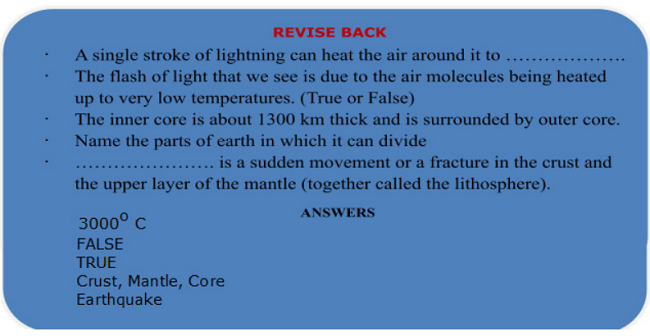
Structure of the earth
Some natural phenomenon of Class 8
About STRUCTURE OF THE EARTH
Initially earth was considered to be a uniform solid but it consists of different concentric shells, like a boiled egg. These shells or layers are divided into three parts, crust, mantle and core. The core is further divided into two layers the outer core and the inner core.
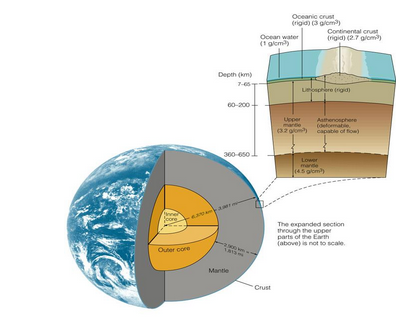
CRUST:
It is the outer layer of earth on which our continents and ocean basins rest. It is thickest in the continental regions where it has an average thickness of 40 kilometres and thinnest in the oceans where it may have maximum thickness of about 10 to 12 km.
MANTLE:
The layer beneath the earth's crust is called the mantle. Mantle is important because it accounts for nearly half of the radius of the earth (2900 km). The dynamic processes which determine the movements of the crust plates are powered by the mantle. The mantle is a shell of red hot rock and separates the earth's metallic and partly melted rock (both the inner and the outer rocks) from the cooler rocks of the earth's crust. It consists of silicate minerals rich in magnesium and iron. The density of mantle increases with depth from about 3.5 grams per cubic centimetre to around 5.5 grams per cubic centimetre, near the outer core.
OUTER CORE:
The outer core is around 2300 km thick. The outer core appear to be in molten state. It contains iron and nickel in molten state. It also contains sulphur.
INNER CORE:
The inner core is about 1300 km thick and is surrounded by outer core. It is a solid ball and is composed of iron.
EARTHQUAKE
An earthquake is a sudden movement or a fracture in the crust and the upper layer of the mantle (together called the lithosphere). This causes a series of shocks (movements). An earthquake may range from a mild tremor, which will result in the vibrations of the ground to a large-scale movement of earth causing a widespread damage over a large area.
The branch of science which deals with the earthquakes and related phenomena is called seismology. All the phenomena related to the emergence and manifestations of earthquakes are called seismic.
An earthquake (also known as a quake, tremor or temblor) is the result of a sudden release of energy in the Earth'scrust that creates seismic waves. The seismicity, seismic or seismic activity of an area refers to the frequency, type and size of earthquakes experienced over a period of time. Earthquakes are measured using observations from seismometers.
OCCURRENCE OF EARTHQUAKE :
Earthquakes generally occur at plate boundaries as follows:
(i) As the plates move, they rub against each other. At the edges of the plates where the earth's crust is moving in different directions faults are found .
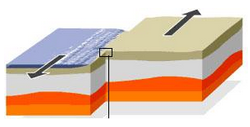
(ii) Sometimes, the rocks of the plates get locked to each other because the jagged edges of the two plates get locked and prevent the plates from moving. As a result, pressure builds up against these rough edges.
(iii) As the build-up pressure continues, a point is reached when the rocks (which are locked to each other preventing the plates from moving) give way. The plates start rolling in the direction in which they were moving. This results in earthquake.
Focus is the point where the rocks give way. The point vertically above the focus on the surface of the earth is called the epicentre.
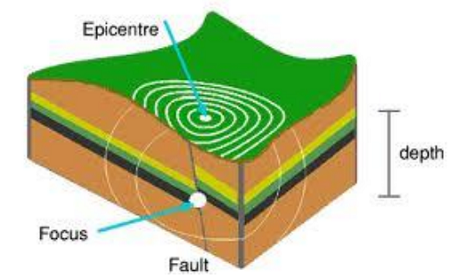
(iv) Vibrations caused by an earthquake travel in the form of a wave within the earth or along the surface of the earth. These waves are called seismic waves.
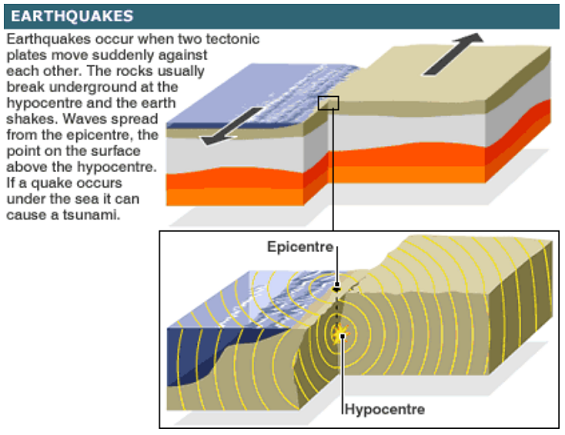
There are several types of earthquake waves including P, or primary waves, which are compressional and travel fastest; and S or secondary waves, which are transverse, i.e., they cause the earth to vibrate perpendicularly to the direction of their motion. Surface waves consist of several major types and are called L, or long, waves. Since the velocities of the P and S waves are affected by changes in the density and rigidity of the material through which they pass, the boundaries between the regions of the earth known as the crust, mantle, and core have been discerned by seismologists, scientists who deal with the analysis and interpretation of earthquake waves Seismographs are used to record P, S, and L waves. The disappearance of S waves below depths of 1,800 mi (2,900 km) indicates that at least the outer part of the earth's core is liquid.

